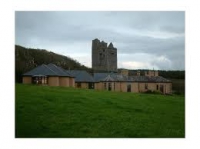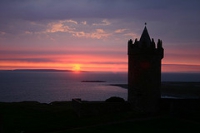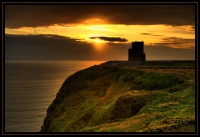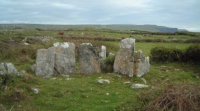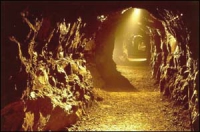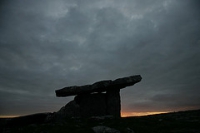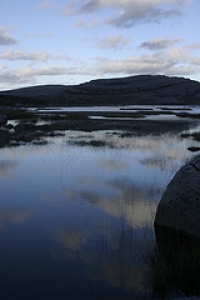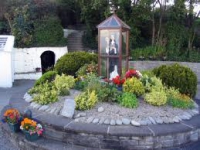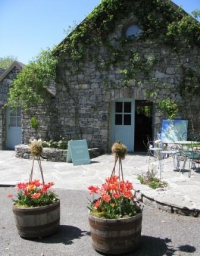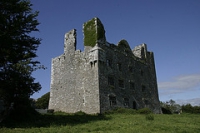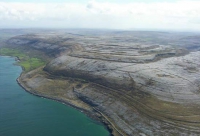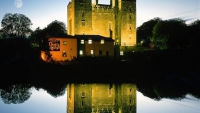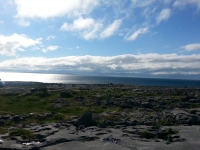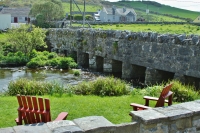The Burren is rich with historical and archeological sites, including 90 megalithic tombs, portal dolmens and many rings forts
Visible from the Aille River Hostel, the Knooclstoolery standing stone has a commanding presence from the hill overlooking the centre of Doolin. It is likely prehistoric.
Built by Thomas McNamara in 1783, this house had a central role in Doolin's history. France McNamara, a prominent landlord, entertained many literary figures here and encouraged natural bathing in the area. The house was burnt to the ground by the Black and Tans in 1920 in retaliation for an IRA ambush.
There are at least 14 coastal ring fort ruins along the coast of Doolin. They are good examples of early Bronze Age and Iron Age burial grounds, dating from 2000 BC to about 200 BC.
Built aroud the 15th century.
This 15th century castle is a ruin of the O'Brien Clan.
This castle is a round 16th-century tower house with a small walled enclosure located about 1Km above the coastal village of Doolin . Its name may mean "the fort of the rounded hills" or the "fort of the goats"; it sits on a hill overlooking Doolin Point and is used as a navigational point by boats approaching Doolin Pier. Doonagore Castle is at present a private holiday home, inaccessible to the public.
O'Brien's Tower was built in 1835 by Cornelius O'Brien a descendant of Brian Boru, Kings of Thomond, as an observation point for the hundreds of tourists who even then, visited the Cliffs. The tower stands proudly on a headland of the majestic Cliffs of Moher.
Built in 1470, the church served Doolin and area until 1840. It then served as a burial ground, with graves dating from 1860 to 1985.
Of all the worked minerals in the Burren, the mining of the phosphate deposits at Doolin and at Noughaval (3.2 km north-east of Kilfenora) was the largest enterprise.
Teergonean (land without birds) is a little-visited tomb at the end of a dirt road past Killilagh chuch.
These 214 metre cliffs are an imposing sight and not to be missed. The new visitor's centre at the top of the cliffs offers information about the flora and fauna the cliffs shelter.
A 10 minute drive will bring you to the new visitor's centre where breathtaking views from the highest points of the cliffs can be seen.
This cave was formed by the glacial melt waters of an early ice age. The erosive power of the waters carved out an subterrainian river deep underneath Aillwee mountain. This river has subsided since the last ice age, leaving behind one of Ireland's most stunning caves.
Poulnabrone portal tomb or dolmen is one of the best known ancient tombs in Ireland.
Is dedicated to St. Fachtna, who founded his monastery here during the sixth century. The original church was probably wooden and was later replaced by a stone building.
The Caherconnel Stone Fort is a large and perfect fort, 140 feet to 143 feet in external diameter, nearly circular in plan, and girt by a wall with two faces and large filling; it is 12 feet thick, and from 6 feet to 14 feet high, being most perfect towards the west
Is a beautiful spiral type stoney hill (627 ft) located in the heart of the burren and surrounded by shallow blue/green loughs.
A lovely red sand beach with a backdrop of delicate sanddunes acting as protection against the wild Atlantic winds.
Seaworld and Leisure Centre invites you to explore the world beneath the waves and discover the awesome wealth of the Atlantic Ocean in a thrilling and dramatic way.
The National Parks & Wildlife Service welcomes you to Coole Park which, together with the adjoining Garryland, is a Nature Reserve of approximately 405 hectares (1000 acres). The seven woods celebrated by W.B. Yeats are part of the 6 kilometres of nature trails taking in woods, river, turlough, bare limestone and Coole lake.
An innovative show room filled with the earth's natural treasures, most are on sale, and there is something for everyone.
Moher Hill Open Farm and Leisure Park provides attractions for young and old, native and tourist.
The tradition about this saint is, that she led the Virgin Mary to the place of purification on the 2nd of February, and that the 1st of February was dedicated to herself on that account.
Located in the heart of the Burren, the Burren Perfumery and Flora Centre is Ireland's oldest perfumery shop and worth a stop for their audio visual and photographic exhibitions.
This castle has a formiddable presence at the crossroads between Kilfenora, Corofin and Carran and is an excellent example of two-part construction, having one portion built in the 15th century, with an additionin the 17th century.
From the bare and windswept Black Head, where the coast road from Burren reaches its most northerly point, there are extensive views over Galway Bay. From here the road runs southeast along Ballyvaughan Bay.
The most complete and authentic medieval castle in Ireland, Bunratty was originally built in 1277.
Continuing down the lane behind the Aille River hostel brings you to the rugged limestone landscape that is the beginning of the Burren. Wildflowers abound here, and wild goats can often be spotted. There are also numerous archaelological sites dotted along the coast.
From the front door of the Aille River Hostel your view takes in this 15th century bridge unique for being one of only a few flat bed bridges in Ireland.
Doolin Cave- Discovered in 1952, the Great Stalactite at Doolin Cave, is becoming one of the most important eco-tourist attractions in Ireland.


